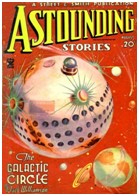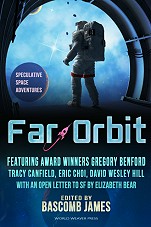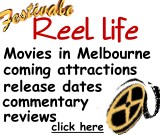Summer 2015-6
Grand Tradition Science Fiction
Stories that Want to Have Fun
Grand Tradition (GT) science fiction (SF) is a writing and storytelling style popular in mid-century SF publications. These plot-driven adventures were unabashedly fun to read and most of them included a "Harrah" moment at the end. GT stories were written in every SF motif (horror, noir, pulp fiction, first contact, spaceship, alien invaders/visitors, political intrigue, hard science fiction, etc.) and they embraced all of the familiar SF tropes.
This storytelling style was notable for its overall optimism, respect for science, and sense of adventure. While GT often included social/political commentaries, these elements were not the main focus of the story. The major focus was the adventure, the wonder, and the delightful romp through a strange and wondrous universe.
The Early Days

Grand Tradition SF had its literary roots in the pulp fiction era but the writing style was heavily pruned and shaped by Hugo Gernsback's "Super Science" era that focused on the gizmo and by John W. Campbell's desire for more scientific achievement and realism. Gernsback was the founder and editor of "Amazing Stories," the first English language magazine dedicated to science fiction. Campbell was the influential editor of "Astounding Science Fiction" which was later renamed "Analog."
These influential editors shaped the course of early American SF and their editorial preferences infused the GT writing style with a general respect for science and scientific achievement. Despite their obvious influence, the GT storytelling style never fully fit within either editor's story model because the scientific elements were part of the story's subtext rather than its main focus. Despite this dichotomy, both Gernsback and Campbell published many GT stories that were well received by the SF readership.

The popularity of GT storytelling faded significantly by the late 1950s aided, in part, by the continued use of lurid magazine covers featuring monster aliens and scantily clad women. This practice tended to undermine the growing respectability of the genre and perpetuated the SF's image as sensational escapist fiction appealing only to adolescents. SF was having an identity crisis as it readership changed.
The ultimate demise of GT storytelling came when Galaxy magazine and other newcomers began paying premium prices for a more literary form of science fiction that took its cues from mainstream literature. Fun stories - stories written purely for entertainment - became childish indulgences in an increasingly literary world.
Grand Tradition Stories Today

One form of GT storytelling, the Space Opera, has become increasingly popular subgenre fueled, in part, by the success of Star Wars movies, the Babylon 5 franchise, Battlestar Galactica, and Guardians of the Galaxy. The literary world also seems to have embraced well-written Space Operas and from 1982 to 2002, the Hugo Award for best science fiction novel was commonly been given to a space opera nominee.
Contrary to popular belief, there is more to GT storytelling than Space Opera and in 1998, Gardner Dozois put together a GT anthology, The Good Old Stuff, which featured 16 Grand Tradition stories dating from the late 1940s to the 1970s.(1) A second anthology, The Good New Stuff followed in 1999. This second anthology featured 17 stories written in the 1970s through the 1990s.(2) The volume demonstrated that Grand Tradition science fiction is still being written and published.

In 2014, World Weaver Press published Far Orbit: Speculative Space Adventures (3) and a second anthology, Far orbit Apogee (4) followed in 2015. There were thirteen stories in each anthology -- three recent reprints and ten new GT stories.
The future of Grand Tradition Science Fiction
Science fiction is a literature of ideas and as such, it embraces a wide range of literary styles and subgenre. Grand Tradition SF stories will continue to be published because they appeal to readers like Elizabeth Bear who want a little more fun and less grit in their SF.(5) GT stories also appeal to readers like Stephen Donaldson and others who want their SF stories to be more optimistic and incorporate the hopeful visions of the future that were prevalent in mid-20th century SF.(6)
Science Fiction is also a literature of inclusion. We include aliens, robots, and unseen god-like civilizations into our literature. Our literature includes military stories, horror stories, romance stories, stories of dystopia and despair, stories of hope and optimism, detective stories, thrillers, and espionage stories. We have found a place for all these SF story types and more. I believe we will continue to find a place for Grand Tradition science fiction too.
Suggested Reading
Suggested Reading: 1.Dozois, Gardner and Jonathan Strahan (eds). "The New Space Opera." Harper Collins, New York, NY (2007). 2.Dozois, Gardner, and Jonathan Strahan (eds). "The New Space Opera 2". Harper Collins, New York, NY (2009) 3.James, Bascomb (ed). "Far Orbit: Speculative Space Adventures." World Weaver Press, Alpena, Michigan (2014). 4.James, Bascomb (ed). "Far Orbit Apogee." World Weaver Press, Alpena, Michigan (2015).
Literature Cited
1.Dozois, Gardner (ed). "The Good Old Stuff: Adventure SF in the Grand Tradition." St. Martin's Griffin, New York, New York (1998)
2.Dozois, Gardner (ed). "The Good New Stuff: Adventure in SF in the Grand Tradition." St. Martin's Griffin, New York, New York (1999)
3.James, Bascomb (ed). "Far Orbit: Speculative Space Adventures." World Weaver Press, Alpena, Michigan (2014).
4.James, Bascomb (ed). "Far Orbit Apogee." World Weaver Press, Alpena, Michigan (2015).
5.Bear, Elizabeth. "Another Word: Dear Speculative Fiction, I'm Glad We Had This Talk." Clarkesworld, May 2012
6.Newitz, Annalee. "Dear Science Fiction Writers: Stop Being So Pessimistic!" Smithsonian Magazine, April 2012

Bascomb James is the anthologist and editor of Far Orbit: Speculative Space Adventures (2014) and Far Orbit Apogee (2015). Bascomb is currently reading submissions for the third Far Orbit volume, Last Outpost which has a military science fiction theme.
www.bascombjames.com
Twitter: @BascombJ
See also in this series:
The Immortal Enduring Vampire by Rhiannon Frater
Get Ready Cyberfunkers: Black Science Fiction by K. Ceres Wright
Defining Horror by Jeani Rector
Steampunk: A Marvellous Excursion by Michael Pryor
Female Private Eyes in Fiction: From Lady Detectives to Hard-Boiled Dames by Colleen Collins
The Good, the Bad and the Ugly: Western Writing by Julia Robb
Grand Tradition Science Fiction: Stories that Want to Have Fun, by Bascomb James
Unintended Invention: The Fantasy of Manners, by Ellen Kushner
For posts about Melbourne events, places, news, reviews, giveaways, see our Facebook Page:







 Published in Melbourne, Victoria, Australia
Published in Melbourne, Victoria, Australia